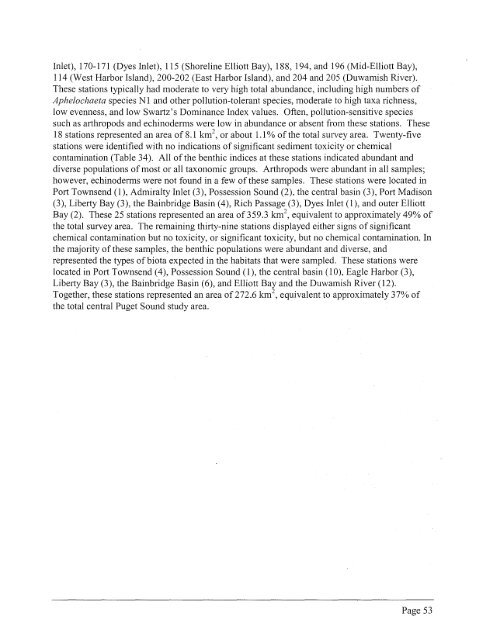Sediment Quality in Puget Sound Year 2 - Center for Coastal ...
Sediment Quality in Puget Sound Year 2 - Center for Coastal ...
Sediment Quality in Puget Sound Year 2 - Center for Coastal ...
Create successful ePaper yourself
Turn your PDF publications into a flip-book with our unique Google optimized e-Paper software.
Inlet), 170- 17 1 (Dyes Inlet), 1 15 (Sl~orel<strong>in</strong>e Elliott Bay), 188, 194, and 196 (Mid-Elliott Bay),<br />
114 (West Harbor Island), 200-202 (East Harbor Isla~~d), and 204 and 205 (Duwamisl~ River).<br />
These stations typically had moderate to very high total abundance, <strong>in</strong>clud<strong>in</strong>g lligll numbers of<br />
Apizelocizuetu species Nl and other pol1utio11-tolerant species, moderate to high taxa ricllness,<br />
low evenness, and low Swartz's Dom<strong>in</strong>ance Index values. Often, pollution-sensitive species<br />
such as arthropods and ecl~<strong>in</strong>oderms were low <strong>in</strong> abundance or absent from these statio~~s. These<br />
18 stations represented an area of 8.1 km2, or about 1.1 % of the total survey area. Twenty-five<br />
stations were identified with 110 <strong>in</strong>dications of significant sediment toxicity or cl~emical<br />
contam<strong>in</strong>atio~~ (Table 34). A11 of the benthic <strong>in</strong>dices at these stations <strong>in</strong>dicated abundant and<br />
diverse populations of most or all taxonomic groups. Arthropods were abundant <strong>in</strong> all samples;<br />
l~owever, ech<strong>in</strong>oderms were not found <strong>in</strong> a few of these samples. These stations were located <strong>in</strong><br />
Port Townsend (I), Admiralty Inlet (31, Possession <strong>Sound</strong> (2), the central bas<strong>in</strong> (31, Port Madison<br />
(31, Liberty Bay (31, the Ba<strong>in</strong>bridge Bas<strong>in</strong> (41, Rich Passage (31, Dyes Inlet (I), and outer Elliott<br />
Bay (2). These 25 stations represented an area of 359.3 km2, equivalent to approxi~nately 49% of<br />
the total survey area. The rema<strong>in</strong><strong>in</strong>g thirty-n<strong>in</strong>e stations displayed either signs of significant<br />
chemical contam<strong>in</strong>ation but no toxicity, or significant toxicity, but no chemical contam<strong>in</strong>atio~~. In<br />
the majority of these samples, the benthic populatio~ls were abundant and diverse, and<br />
represented the types of biota expected <strong>in</strong> the habitats that were sampled. These stations were<br />
located <strong>in</strong> Port Townsend (41, Possessio~~ <strong>Sound</strong> (I), the central bas<strong>in</strong> (I O), Eagle Harbor (3),<br />
Liberty Bay (31, the Ba<strong>in</strong>bridge Bas<strong>in</strong> (61, and Elliott Bay and the Duwamish River (12).<br />
Together, these stations represented an area of 272.6 km2, equivalent to approximately 37% of<br />
the total central <strong>Puget</strong> <strong>Sound</strong> study area.<br />
Page 53







